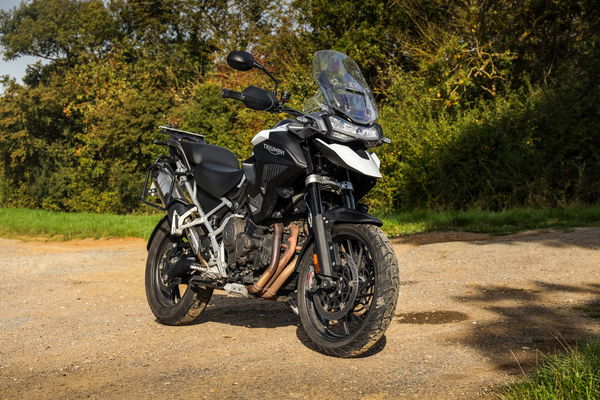Aprilia SL750 Shiver vs Triumph Street Triple
The pool of great-looking alternative sports machines continues to grow, welcome then, to the Shiver and Street Triple

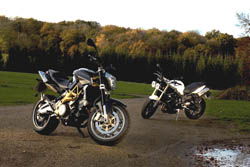 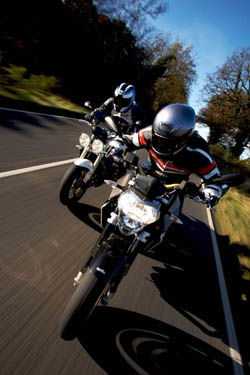 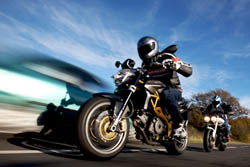 Aprilia SL750 Shiver video2008 CBR1000RR SpecificationPrice:£9,995 basic, £11,995 as tested | Engine: 1,170cc, air-cooled, 4v boxer | Power: 105hp @ 7,250rpm | Torque: 85bhp @ 5,500rpm | Front suspension: Telelever, full adj | Rear suspension: ESA Paralever | Front brake: 280mm discs, four-piston | Rear brake: 265mm disc, two-piston | Dry weight: 210kg (claimed) | Seat height: 895mm | Fuel capacity: 33L | Top speed: 132mph (est) | Colours: Red, Black | | ||
-->
Standing in the crisp winter air I couldn’t help but admire the looks of these two bikes. Both Aprilia’s Shiver and Triumph’s Street Triple stand out from the crowd. Neither is particularly overstated, although the Aprilia’s gold frame is a bit excessive, but they both cut a clear and defined line from the normal. And by normal I mean a Japanese middleweight streetbike.
But can any of the Japanese bikes really be called normal? The likes of Honda’s Hornet and Kawasaki’s Z750 are desperately trying to not fall into this category by having sharp, angular looks, and quirky lines. But they are trying too hard and over-egging the pudding. Cool style isn’t really something that the Japanese do well, they tend to err on the side of the wacky rather than the effortlessly eye pleasing. Which is probably why their bikes look out of date so quickly. Wacky has a limited shelf life.
The Japanese also have a common consensus when it comes to middleweights – inline four is best. But why is this, is there something particularly special about the inline four engine that lends itself to this class? It wouldn’t seem so. Middleweights tend to be aimed at newer riders, commuters or just those who want cheap, light and hassle-free riding. While an inline four might offer a softer power delivery and a faster top end, is this really the ideal blend? What about the real alternatives...
This is where the Shiver and Street Triple come in. Although the Shiver isn’t alone in offering V-twin power it’s bigger in capacity than its closest rival, the SV650, and has a far fresher look, more power and the added kudos of an Italian badge on the tank. You pay the extra, SVs retail at £4,399 while the Shiver costs £5,899, but with the Shiver you get radial brakes, ride-by-wire throttle, inverted forks and a whole host of less than budget components. In many ways it’s unfair to compare the two bikes. Think of the Shiver as a rival to the similarly priced Hornet or Z750 as the specs are more comparable. And it’s the same with the Street Triple. With a £5,349 price the Triumph appears to be one if the best value bikes around, which is probably why buyers have snapped them up, creating a nationwide shortage until June 2008. In offering something different it would appear Triumph provided what the market was looking for.
Aprilia’s Shiver is looking for a similar success.
Having read a fair few glowing reports on the Shiver I was looking forward to riding the bike. I like the concept behind it and admire Aprilia for making a budget middleweight with some real poke as well as the latest technology, rather than just re-hash a current model or engine. But having ridden the Shiver I’m left slightly disappointed, because like a few other of Aprilia’s models it feels as though this bike is so near to being a great machine, but has just fallen short at the last hurdle.
My biggest complaint is the throttle response. Big V-twins often have issues when they are injected because of the nature of the engine. It’s very hard to make the throttle response smooth when you have two fist-sized pistons delivering thumping amounts of torque. To address this Aprilia has dialled in a kind of delay into the fuel-injection map, to soften the initial kick of power to make the bike more ‘friendly’ to ride. Opening the throttle from closed brings with it what feels like a slight hesitation before the power comes in, and when it does the initial response is sluggish and muted. Rather than aid the user-friendliness of the bike I found it intensely annoying as the pause often made me think the bike was about to stall. Also if, like myself, you are used to blipping the throttle on down shifts this pause means that by the time the engine responds to your blip you have started letting the clutch back out, which is again really annoying.
At first I though this little quirk was my imagination, or was due to fingers frozen by the cold temperature not working right, but a quick ride on the Street Triple revealed otherwise.
Even after a few meters it’s obvious why the Street Triple has proved such a huge success. It would have been so easy for Triumph to make it a horrible bike, the potential for disaster was always there. The Street Triple could have been a nasty rev-happy race bike with flat bars, but it isn’t. The little triple engine provides smooth, strong amounts of torque from the word go with a smooth, and very crisp throttle response. It doesn’t matter where you are in the Triumph’s rev range, the engine is always ready to respond, and it does so with a fantastic triple burble from it’s twin exhausts as well. There is none of the aggression of the Aprilia, just gentle, yet still rapid, acceleration that feels perfect in most situations. Learner or experienced rider, the Triple’s motor has bags of performance to offer as well as plenty of character.
The key to it is the way it feels natural, it just clicks with anyone who rides it. Where the Aprilia requires thought due to the odd throttle response and sporty handling the Street Triple is just...right.
Because bikes are such tactile objects each manufacturer’s product always has a certain feel to it, a character. This may be due to the test team that develop the bike, or even the roads they ride on, but it’s always the same. With Aprilias this feeling is always one of slight harshness and a thinly-veiled sporty side, which is apparent in the Shiver. Once the Aprilia is moving the motor reveals itself as a hugely impressive lump. Despite only being a 750 the V-twin is very powerful, delivering a strong top-end kick of power that is enough to make the front go light in second gear. This is something I didn’t expect from a middleweight bike and is indicative of Aprilia’s character. To go with a lovely raw twin sound the Shiver rockets forward at a pace that would certainly leave most naked 600s in its trail. It’s impressive, extremely fun and certainly the bike’s best feature, because again, like other Aprilia models such as the Tuono the ride is a bit on the harsh side.
I’m not sure where Aprilia test ride their bikes, but the roads much be mirror smooth as every Aprilia I ride is set up too harsh for British roads, and the Shiver is no exception. Get aggressive with the bike, really put the hammer down, and the suspension starts to work well, but at ‘normal’ speeds it isn’t that pleasant. There seems too little damping in the forks, meaning that the ride is choppy and firm. Compare it to the sublime setup of the Street Triple (which has obviously been ridden the length and breath of Britain) and the Shiver feels skittish and no where near as reassuring. Bearing in mind who this bike is aimed at, and that’s a bit of an oversight. As is the front brake set-up.
On visual inspection the Shiver’s radial brakes look as though they will be head and shoulders above the Triumph’s old-school sliding callipers. But power isn’t everything, especially in a newbie bike. The Shiver’s brakes have virtually no feel, they have the power, just none of the forgiving initial bite of the Street Triple. Brake hard on the Aprilia and it’s an all or nothing affair, there isn’t a progressive build up of force. Give the radial brakes a panic squeeze and you’ll be down faster than you know it, as TWO’s design staffer found. A 10mph front end crash due to simply locking the front wheel because the car ahead had stopped faster than he was expecting. A typical new rider crash and one that would have been unlikely on the Triumph due to its smoother initial bite. Power with control, that’s the key to a new rider friendly machine. You either have it or you don’t.
Which is exactly why Triumph’s Street Triple has proved such a huge hit, and why I’m not convinced the Shiver will be such a smash. The Street Triple has a realistic price tag, brand recognised looks and a well sorted chassis all combined in a very user-friendly package that also appeals to the more experienced riders. The Shiver, on the other hand, feels as if it needs another year’s development. I’ve heard that Aprilia is trying to dial out some of the stutter from the fuel-injection, which shouldn’t be a problem with the ride-by-wire throttle, and I’m certain owners could set-up the suspension to be more suiting to British roads. If this is done the Shiver would be a far better bike, it already has a fantastic engine and great looks, it just needs a softer side. If I was test riding these two as a new rider I would find the Aprilia intimidating and the Triumph is comforting. As an experience rider I wouldn’t be prepared to put up with the Shiver’s quirks.
The market is certainly there for a different, good looking, easy going middleweight with real character. The backlog for Street Triples has proved this, but until Aprilia can provide a package that feels finished I reckon riders will have to get in line and join the back of the Triumph queue.
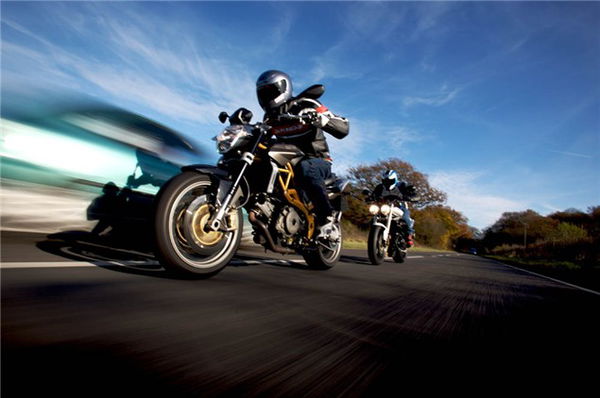
Standing in the crisp winter air I couldn’t help but admire the looks of these two bikes. Both Aprilia’s Shiver and Triumph’s Street Triple stand out from the crowd. Neither is particularly overstated, although the Aprilia’s gold frame is a bit excessive, but they both cut a clear and defined line from the normal. And by normal I mean a Japanese middleweight streetbike.
But can any of the Japanese bikes really be called normal? The likes of Honda’s Hornet and Kawasaki’s Z750 are desperately trying to not fall into this category by having sharp, angular looks, and quirky lines. But they are trying too hard and over-egging the pudding. Cool style isn’t really something that the Japanese do well, they tend to err on the side of the wacky rather than the effortlessly eye pleasing. Which is probably why their bikes look out of date so quickly. Wacky has a limited shelf life.
The Japanese also have a common consensus when it comes to middleweights – inline four is best. But why is this, is there something particularly special about the inline four engine that lends itself to this class? It wouldn’t seem so. Middleweights tend to be aimed at newer riders, commuters or just those who want cheap, light and hassle-free riding. While an inline four might offer a softer power delivery and a faster top end, is this really the ideal blend? What about the real alternatives...
This is where the Shiver and Street Triple come in. Although the Shiver isn’t alone in offering V-twin power it’s bigger in capacity than its closest rival, the SV650, and has a far fresher look, more power and the added kudos of an Italian badge on the tank. You pay the extra, SVs retail at £4,399 while the Shiver costs £5,899, but with the Shiver you get radial brakes, ride-by-wire throttle, inverted forks and a whole host of less than budget components.
In many ways it’s unfair to compare the two bikes. Think of the Shiver as a rival to the similarly priced Hornet or Z750 as the specs are more comparable. And it’s the same with the Street Triple. With a £5,349 price the Triumph appears to be one if the best value bikes around, which is probably why buyers have snapped them up, creating a nationwide shortage until June 2008. In offering something different it would appear Triumph provided what the market was looking for. Aprilia’s Shiver is looking for a similar success.
Continue Aprilia SL750 Shiver vs. Triumph Street Triple

